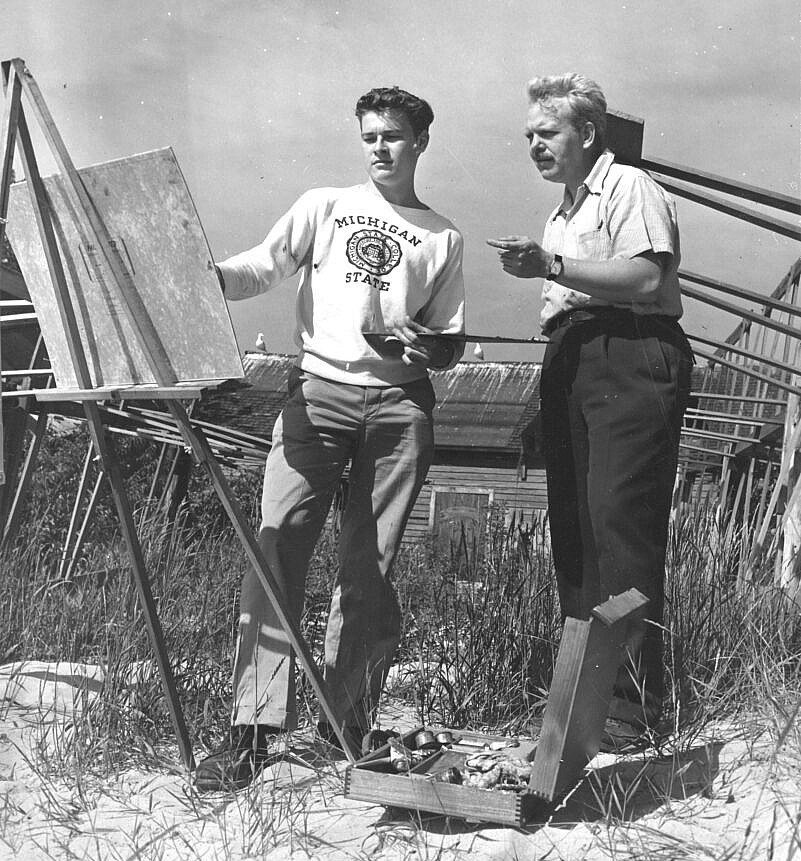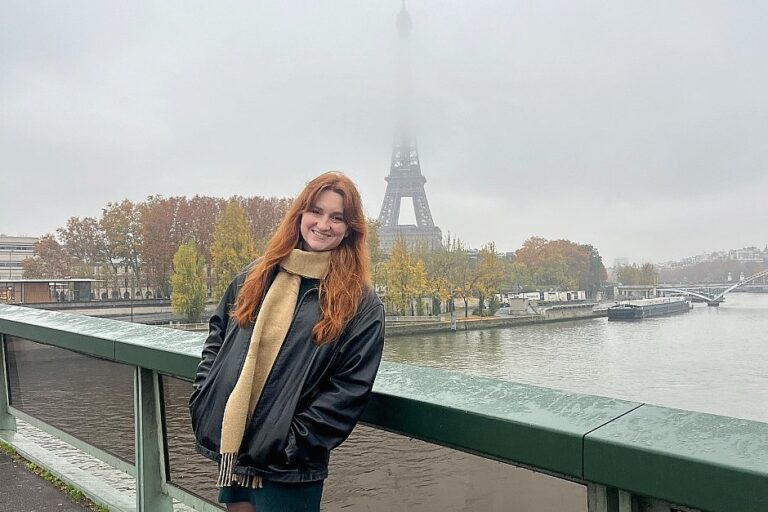The Michigan State University Summer Art Program, which ran for 50 years from 1939 to 1989 in Leland, Michigan, is being celebrated with an exhibit, titled A Summer Romance: MSU Finds Leland, that includes the artwork of 45 former students and faculty members who participated in the program as well as more recent works from program alumni who continued their artistic careers.
The exhibit is part of the 100th anniversary celebration of Leland’s Old Art Building, which is where MSU’s six-week summer art program was held. A Summer Romance: MSU Finds Leland, which runs May 12-18 at the Old Art Building, is the second exhibit in a series of events planned to honor the building’s history and the role it has played in the Leland community.
An opening reception for the exhibit is scheduled for Thursday, May 12, at 5 p.m. and will feature presentations by keynote speakers with important ties to the MSU Summer Art Program.
Birth of MSU’s Summer Art Program
The roots of MSU’s Summer Art Program can be traced back to the Fall of 1938 when Erling Brauner, Professor in the Art Department (now the Department of Art, Art History, and Design) at Michigan State College (now Michigan State University), was tasked with finding a suitable off-campus location for a summer art program.
As Brauner was investigating potential sites for the program along the coast of Lake Michigan, he wandered into a small store in Frankfort, where he saw a photograph of Leland hanging on a wall and was captivated by the image of the small fishing village. He immediately headed north to this Leelanau Peninsula community, where he found, overlooking the Leland River, the vacant Old Art Building (then known as the Walter T. Best Building).

At the time, the Old Art Building was owned by the Walter T. Best Women’s Club, which organized and financed the construction of the building in 1922. The Women’s Club was formed by Allie Mae Best in honor of her late husband who was known nationally as Maro, Prince of Magic, and considered to be one of the most talented magicians of his time. Allie Mae and the Women’s Club imagined the Old Art Building would be a venue suitable for traveling performers and vaudeville acts, further honoring the Prince of Magic’s memory. Unfortunately, the Great Depression and the looming shadow of World War II prevented their dreams from becoming a reality.
Professor Brauner’s contacted the Women’s Club about the idea of holding a summer art program at the building. Pleased that the venue would be used to further the arts, the Women’s Club unanimously voted to donate the building to MSU. This began five decades of summer art programs and a lasting, influential relationship between MSU and the Leland community.
Artists Embraced by Leland Community
Leland proved to be the perfect location for a summer art program with the vivid and varied scenery of the Leelanau Peninsula providing ample inspiration. Students of the program painted Leland’s glorious sunsets, sun-bleached boats, and so much of the beautiful landscape of the area.

“Students find the informal, quaint atmosphere of Leland well suited to painting activity. The village’s small waterfront docks, fish-houses, and boats; the area’s rolling hills, small farms, and inland villages, all provide sources for varied interests,” Brauner was quoted as saying in a program published in 1989 for the 50th anniversary exhibition of the summer art program. “People sometimes ask why we couldn’t stay in East Lansing to do abstract painting, but after all, one doesn’t abstract out of thin air. Even non-representational painters derive stimulation from the light, color, and atmosphere in Leland.”
The scenery only held a small part of Leland’s charm. What made the location truly special was the way Leland residents enthusiastically welcomed program participants into their community each summer.
In 1939, the Leelanau Enterprise wrote an editorial praising the new relationship between MSU and the residents of Leland, stating “Let us give Mr. Brauner and the students all the encouragement and cooperation possible. May the students and teachers go to their homes singing the praises of Leland, may they have nothing but good words for the cordiality of the people.”

This set the tone for the subsequent 50 years of the summer art program where students were free to explore and paint in the mornings, spent the afternoons in critique sessions, and in the evening were often invited to attend parties hosted by local residents and other activities organized by the Leland community.
“Many students rented rooms around the area from locals and became temporary family members [paying as little as $2.50 a week for a room they shared with another student],” said Abby Chatfield, Office Manager at the Old Art Building and one of the organizers of A Summer Romance: MSU Finds Leland exhibit. “Their presence added some flair and culture to the area.”
Growth and Expansion of the Program
MSU’s Summer Art Program initially was designed for graduate students concentrating in painting. For $16.50, they could embark on a six-week artistic retreat, which provided them space to devote to creative endeavors. Each summer session concluded with an exhibition of artwork created in the program. These exhibitions grew to be popular with residents and tourists alike.
Over the years, the program expanded its curriculum. James L. Lawton, Professor in MSU’s Department of Art, Art History, and Design and Program Director at the time, implemented classes in ceramics and sculpture along with scheduling Professors Robert Alexander and Peter Glendinning in offering course work in photography. In addition, the composition of the program began to change as summer residents and public school teachers took part in classes.

“Many in the community, in addition to those enrolled in course work, observed activities in and around the Art Building since the doors were always open to visitors,” Lawton said. “Some site-specific works were installed in the community. The engagement with the community resulted in one situation where a local artist observed what was being taught and returned home to Indiana to establish his own ceramic shell investment and bronze foundry. In another engagement with the people of Leland, an opportunity for a position in an art museum was arranged.”
By 1989, however, MSU students consisted of a small minority in the annual enrollment of the program. This dwindling interest, coupled with the steady decline of affordable summer housing in Leland, lead to the end of MSU’s Summer Art Program.
Program’s Lasting Influence on the Community
Even though the summer art program ended 33 years ago, shades of its influence still color Leland today. Pieces of art created during the program hang in local homes, several of which were loaned for the exhibit. And, it’s not just the art that has lingered in Leland – many students and faculty who attended the program fell in love with the area and returned to make it their home.
“We’ve gained some long-time community members from the program as we have heard time and again from many former students that their experiences in the program inspired them to move to the area. Some of them are active artists who are successful enough to support themselves with their art sales,” Chatfield said. “And, there are so many more artists up here who are not in the show (and who we are unaware of) who participated.”
The influential and long-lasting relationship between MSU and Leland was recognized in 1989 when the Old Art Building gained a place on the Michigan State Register of Historic Sites. This relationship is being recognized once again in A Summer Romance: MSU Finds Leland. The exhibit is free and open to the public each day from 11 a.m. to 3 p.m. at the Old Art Building, 111 S. Main Street in Leland.


